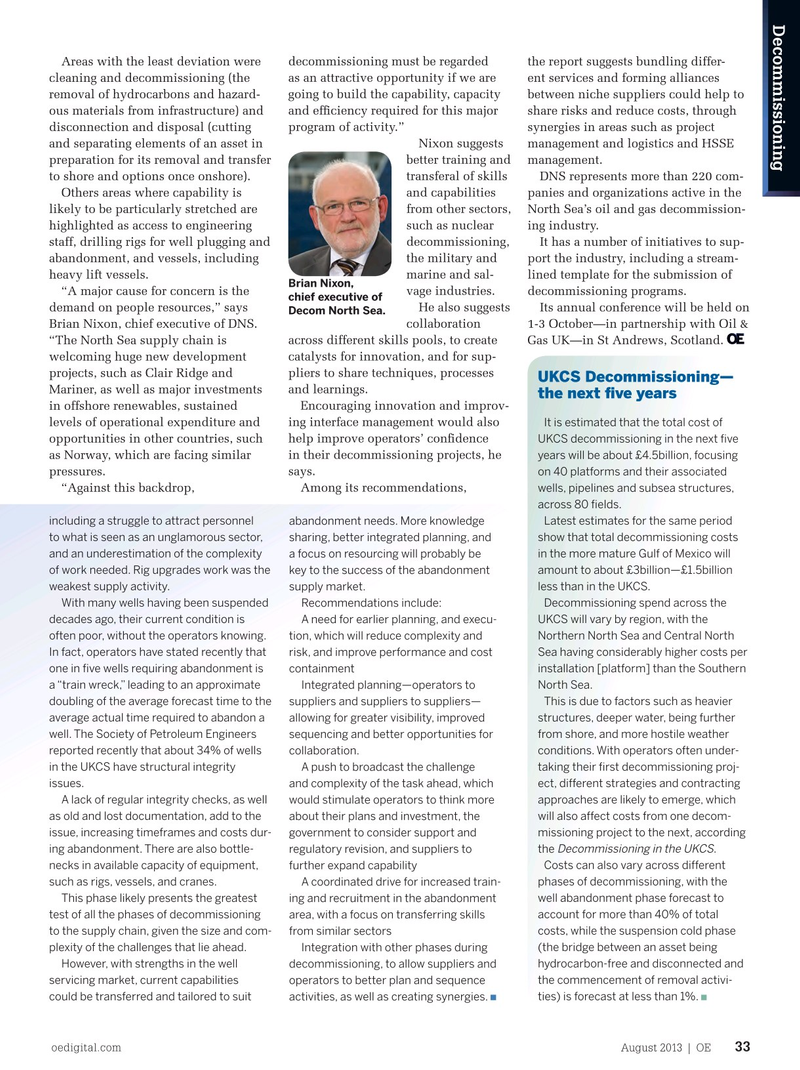
Page 31: of Offshore Engineer Magazine (Aug/Sep 2013)
Read this page in Pdf, Flash or Html5 edition of Aug/Sep 2013 Offshore Engineer Magazine
Decommissioning
Areas with the least deviation were decommissioning must be regarded the report suggests bundling differ- cleaning and decommissioning (the as an attractive opportunity if we are ent services and forming alliances removal of hydrocarbons and hazard- going to build the capability, capacity between niche suppliers could help to ous materials from infrastructure) and and effciency required for this major share risks and reduce costs, through disconnection and disposal (cutting program of activity.” synergies in areas such as project and separating elements of an asset in Nixon suggests management and logistics and HSSE preparation for its removal and transfer better training and management. to shore and options once onshore). transferal of skills DNS represents more than 220 com-
Others areas where capability is and capabilities panies and organizations active in the likely to be particularly stretched are from other sectors, North Sea’s oil and gas decommission- highlighted as access to engineering such as nuclear ing industry. staff, drilling rigs for well plugging and decommissioning, It has a number of initiatives to sup- abandonment, and vessels, including the military and port the industry, including a stream- heavy lift vessels. marine and sal- lined template for the submission of
Brian Nixon, “A major cause for concern is the vage industries. decommissioning programs. chief executive of demand on people resources,” says He also suggests Its annual conference will be held on
Decom North Sea.
Brian Nixon, chief executive of DNS. collaboration 1-3 October—in partnership with Oil & “The North Sea supply chain is across different skills pools, to create Gas UK—in St Andrews, Scotland. welcoming huge new development catalysts for innovation, and for sup- projects, such as Clair Ridge and pliers to share techniques, processes
UKCS Decommissioning—
Mariner, as well as major investments and learnings. the next fve years in offshore renewables, sustained Encouraging innovation and improv- levels of operational expenditure and ing interface management would also
It is estimated that the total cost of opportunities in other countries, such help improve operators’ confdence
UKCS decommissioning in the next fve as Norway, which are facing similar in their decommissioning projects, he years will be about £4.5billion, focusing pressures. says. on 40 platforms and their associated “Against this backdrop, Among its recommendations, wells, pipelines and subsea structures, across 80 felds. abandonment needs. More knowledge including a struggle to attract personnel Latest estimates for the same period sharing, better integrated planning, and to what is seen as an unglamorous sector, show that total decommissioning costs a focus on resourcing will probably be and an underestimation of the complexity in the more mature Gulf of Mexico will key to the success of the abandonment of work needed. Rig upgrades work was the amount to about £3billion—£1.5billion supply market. weakest supply activity. less than in the UKCS.
Recommendations include: With many wells having been suspended Decommissioning spend across the
A need for earlier planning, and execu- decades ago, their current condition is UKCS will vary by region, with the tion, which will reduce complexity and often poor, without the operators knowing. Northern North Sea and Central North risk, and improve performance and cost In fact, operators have stated recently that Sea having considerably higher costs per containment one in fve wells requiring abandonment is installation [platform] than the Southern
Integrated planning—operators to a “train wreck,” leading to an approximate North Sea. suppliers and suppliers to suppliers— doubling of the average forecast time to the This is due to factors such as heavier allowing for greater visibility, improved average actual time required to abandon a structures, deeper water, being further sequencing and better opportunities for well. The Society of Petroleum Engineers from shore, and more hostile weather collaboration. reported recently that about 34% of wells conditions. With operators often under-
A push to broadcast the challenge in the UKCS have structural integrity taking their frst decommissioning proj- and complexity of the task ahead, which issues. ect, different strategies and contracting would stimulate operators to think more A lack of regular integrity checks, as well approaches are likely to emerge, which about their plans and investment, the as old and lost documentation, add to the will also affect costs from one decom- government to consider support and issue, increasing timeframes and costs dur- missioning project to the next, according Decommissioning in the UKCS regulatory revision, and suppliers to ing abandonment. There are also bottle- the .
further expand capability necks in available capacity of equipment, Costs can also vary across different
A coordinated drive for increased train- such as rigs, vessels, and cranes. phases of decommissioning, with the ing and recruitment in the abandonment This phase likely presents the greatest well abandonment phase forecast to area, with a focus on transferring skills test of all the phases of decommissioning account for more than 40% of total from similar sectors to the supply chain, given the size and com- costs, while the suspension cold phase
Integration with other phases during plexity of the challenges that lie ahead. (the bridge between an asset being decommissioning, to allow suppliers and However, with strengths in the well hydrocarbon-free and disconnected and operators to better plan and sequence servicing market, current capabilities the commencement of removal activi- n n activities, as well as creating synergies. could be transferred and tailored to suit ties) is forecast at less than 1%. oedigital.com August 2013 | OE 33 032_OE0813_Decom-UK.indd 33 7/22/13 3:28 PM

 30
30

 32
32